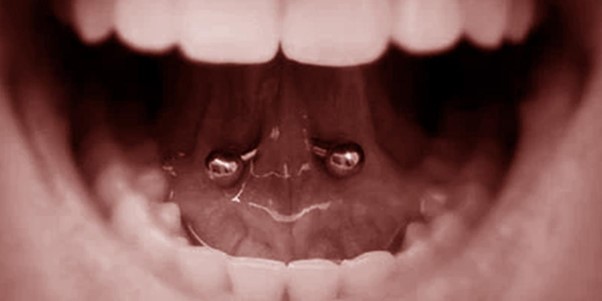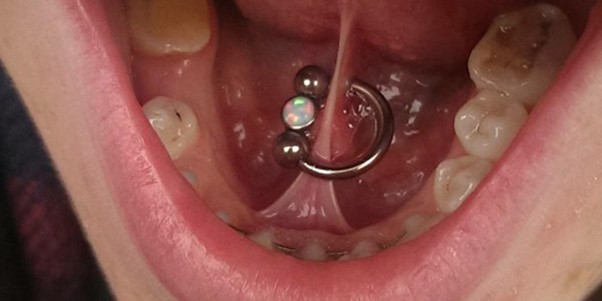Frenulum Piercing
A frenulum piercing is an intriguing, yet quite painful, oral piercing that goes through the thin band of tissue connecting your tongue to the base of your mouth. While a frenulum looks edgy and appealing when healed, you need to be fully prepared for the process of getting this delicate area punctured before jumping into the piercer’s chair. Read on for a comprehensive guide on what to expect before getting a frenulum tongue piercing.
Picking Your Piercer
Without a doubt, the most critical factor in a successful frenulum piercing experience is choosing an extremely experienced and reputable piercing studio. Piercing the thin stretchy tissue of the frenulum takes precision and skill that not all piercers will have. Do your research.
Visit studios in person and look for piercers with specialized oral piercing portfolios. Ask to see healed examples of their frenulum work. A quality studio will have you rinse with an antiseptic mouthwash prior to any oral piercing. They’ll also use fresh disposable needles and follow autoclave sterilization practices. Don’t just go to the trendiest spot – vet piercers carefully.
Placement Matters
Frenulum piercings go directly through the frenulum tissue about midway between the tongue and the inner lip. Proper placement is vital as you want to avoid hitting any veins or nerves that could lead to extensive bleeding and pain. The needle insertion point will be approximately 1⁄4 inch off center.
An inexperienced piercer may struggle with the slightly off-center angling. You want someone confident enough in their anatomy knowledge to pinpoint the exact best location for the piercing channel. Bringing along a photo of a properly done frenulum piercing can help demonstrate optimal placement.
Dealing with the Pain
There’s no sugarcoating it – getting pierced directly through the hypersensitive frenulum is going to hurt…a lot! The tissue is vascular while also being tightly stretched, making it an extremely sensitive area. Many piercers won’t even offer numbing spray due to the intricate nature of the frenulum tissue.
You’ll feel intense pressure and pinching as the needle pushes through the shallow membrane. The tongue is also highly innervated with nerves, so lingering soreness is common. Breathing techniques, meditation, and having a friend accompany you can help cope with the piercing discomfort. For a few days after, eating and talking will be challenging.
Long Healing Time
Understand that a frenulum piercing takes patience and diligent aftercare to fully heal. You can expect a 4-6 week healing period as the tissue mends. During this time, activities like kissing, smoking, and oral sex are off limits. Spicy, acidic or abrasive foods must be avoided as well, as they could irritate the unhealed piercing.
Initial jewelry will be a small diameter captive bead ring or barbell. Avoid playing with the jewelry excessively or changing it during healing. Follow your piercer’s directions for rinsing with non-alcoholic antibacterial mouthwash multiple times per day. Stay hydrated and let the frenulum heal by avoiding touching, flipping or changing the jewelry.
Risk Factors to Consider
While frenulum piercings look awesome when done properly, the risks should not be downplayed. Possible complications include:
– Excessive bleeding during/after piercing
– Damage to the underside of the tongue
– Chipped or cracked teeth from jewelry
– Swelling that restricts eating
– Infection due to oral bacteria
-Loss of sensation in the tongue
– Difficulty healing
-Scar tissue
Meticulous aftercare and avoiding irritants can minimize problems, but issues may still arise. People with thin frenulums or active lifestyles should carefully consider if this piercing is right for them due to the risks and healing needs. Discuss your history thoroughly with your piercer.
The Permanence Factor
Unlike cartilage, oral piercings are not designed to be permanent. The holes will close up over time once the jewelry is removed. Frenulum piercings may start closing in just a few hours after taking the stud or ring out.
While a small white scar may be left behind on the inside of your lip, the piercing will not leave a visible hole if you later opt to take it out. The thin membrane tissue makes it easy for the frenulum to heal. Just know this piercing is a non-permanent addition despite the long healing period.
Caring for Your Piercing
Getting through the initial piercing is just the beginning of the frenulum journey. You must be diligent about proper aftercare while it heals for 4-6 weeks. Here are some tips:
– Rinse mouth with non-alcoholic antibacterial mouthwash 2-3 times daily
– Avoid spicy, hot, crunchy or acidic foods that could irritate
– Do not smoke, drink alcohol or engage in oral sex
– Take ibuprofen as needed for swelling and discomfort
– Gently pat dry the area after cleaning, don’t scrub
– Sleep with head elevated to minimize swelling
– See your piercer if bleeding, pain or redness persists
With attentive aftercare, you can help your frenulum heal properly. Just don’t play with the jewelry and avoid all irritants during the healing phase.
Ready for the Piercing Process?
A frenulum piercing brings an undeniable edge to your oral style, but only if you’re fully prepared. From seeking out a highly skilled piercer to dealing with the significant pain, healing time and risks, know what you’re getting into beforehand. For many enthusiasts, the effort is worth it for the unique frenulum addition. Just do your research to make educated choices.

